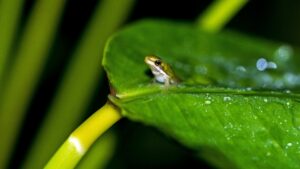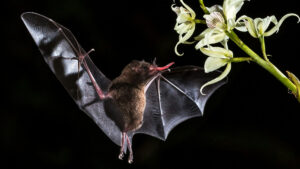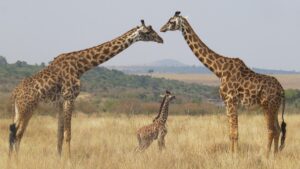Amidst a whirlwind of fleeting trends, hashtags, and viral sensations that are as ephemeral as a shooting star, some remarkable animals stand as living testaments to the relentless passage of time. From ancient tortoises to age-reversing jellyfish, we unveil the oldest living animals on Earth. These extraordinary beings have not just seen it all but have experienced epochs beyond our imagination!
Jonathan the tortoise: Ageless wonder
Imagine a creature that has seen the invention of the light bulb, the moon landing, and countless iPhone generations. Meet Jonathan, an Aldabra giant tortoise, born around 1832 on the island of Saint Helena. If he could talk, he’d probably share some interesting tales about Napoleon’s exile on the very same island!
Jonathan’s secret to being one of the oldest living animals on Earth? Well, it’s not rocket science. He’s mastered the art of taking it slow — literally. In a world of constant hustle and bustle, perhaps we can learn a thing or two from Jonathan about the benefits of a more laid-back lifestyle.
Ocean quahog: A clam that’s the oldest living animal

For some people, clams may seem about as exciting as watching paint dry, but the ocean quahog has a fascinating story to tell. Some of these unassuming clams, found in the North Atlantic, have been discovered to be over 500 years old. This age makes the ocean quahog the oldest living animal on Earth, per Guinness World Records. Just think about it — they were around during the Renaissance, the Industrial Revolution, and the invention of the internet.
Why do ocean quahogs live so long? Well, they move at a glacial pace, buried deep in the ocean’s icy depths. It’s as if they found the ultimate anti-aging spa treatment by accident. In the hustle and bustle of modern society, maybe it’s time we learn to slow down and appreciate the journey.
Turritopsis dohrnii: Age-reversing immortal jellyfish
Jellyfish are usually associated with the word “sting.” However, the Turritopsis dohrnii, also known as the Immortal Jellyfish, has “Benjamin Button” capabilities — which adds a surprising twist to its reputation. When faced with adversity, these jellyfish can essentially hit the rewind button on their life cycle and start over as juveniles.
While we can’t exactly reverse the clock like these underwater wonders, we can embrace change with the grace of a jellyfish. Instead of fearing the unknown, why not approach life’s challenges with curiosity and resilience?
Hydra: Tiny but mighty
Hydras may look like the alien cousins of a household plant, but don’t let their appearance fool you. These minuscule aquatic organisms, found in freshwater habitats, possess a remarkable ability to regenerate — similar to the immortal jellyfish. When injured or stressed, hydras can revert to their juvenile state, starting life anew.
While we can’t perform the same trick, we can adopt a more youthful outlook on life. Embrace change, stay curious, and don’t be afraid to hit the reset button when life throws you a curveball. After all, it’s not about the size of the creature but the resilience of its spirit.
Matusalem: The wise macaw
Move over, parrots that can mimic speech — there’s a macaw in town with a fascinating life story. Matusalem, a blue-and-yellow macaw, holds the Guinness World Record for the world’s oldest parrot. Born in 1899, this feathery fellow has witnessed over a century of history, from the Wright brothers’ first flight to the rise of the digital age.
Matusalem’s secret? Well, he’s a parrot, so he probably picked up a thing or two by eavesdropping on conversations throughout the years. Jokes aside, his remarkable longevity serves as a reminder that having a zest for life and a colorful personality can keep us feeling young at heart.
Greenland shark: Cold-water explorer that’s 1 of the oldest living animals
Let’s dive deep into the frigid waters of the North Atlantic and meet the Greenland shark, a mysterious creature known for its extreme longevity. Some of these sharks have been estimated to be over 500 years old, making them some of the longest-lived animals on Earth.
Scientists believe the Greenland shark’s longevity has to do with its slow metabolism and the icy temperatures of its habitat. While we can’t all move to the Arctic, we can certainly take inspiration from the resilience of these sharks when facing life’s challenges.
Lonesome George: The iconic tortoise
No list of the oldest living animals on Earth would be complete without mentioning Lonesome George, the Pinta Island tortoise who became an icon of conservation. Born sometime around 1910, Lonesome George was the last of his kind and the rarest creature on the planet.
While Lonesome George’s story is tinged with sadness due to the loss of his species, his legacy reminds us of the importance of preserving biodiversity and protecting endangered species. In his memory, let’s work together to ensure that future generations of animals don’t face the same fate.
Bowhead whale: Gentle giant of the Arctic
Last but certainly not least, we have the bowhead whale, a true behemoth of the Arctic seas. These majestic creatures can live for over 200 years, making them some of the longest-lived mammals on Earth.
The bowhead whale’s longevity likely lies in its diet of slow-growing, energy-rich food and the fact that they don’t face many natural predators in its icy habitat. As for us, it’s a reminder to choose our diets wisely and surround ourselves with positive influences.
The oldest living animals on Earth
When everything around us seems fleeting and temporary, these remarkable creatures serve as reminders that life can endure and thrive against the relentless march of time. While we may not have the same longevity capabilities as the oldest living animals on Earth, we can certainly learn valuable lessons from their resilience, adaptability, and ability to embrace change.
Whether it’s taking life at a slower pace like Jonathan the Tortoise, or hitting the reset button when life throws you a curveball like the immortal jellyfish, let’s celebrate the wisdom of these enduring animals and apply their life lessons to our journey through time.
RELATED: Dog Breaks World Record for the Longest Tongue — Longer Than a Soda Can!
Header image: Jonathan the Tortoise / Xben911 via Wikimedia Commons
I’m Mark Putzer, and my passion for animals and all things nature is a life-long love affair. Growing up in Wisconsin, I had many cherished memories of hiking, skiing, and enjoying the abundant wildlife in the Badger State.
My passion for animals led me to marine biology research for my studies at the University of Wisconsin. I researched the behavior and communication of humpback whales around Hawaii and Orca Whales around the San Juan Islands of Washington State. The experience of being close to these massive and magnificent creatures is amazing. Later, I taught outdoor education to children in California — passing along my knowledge of animals and nature to the curious minds of the next generation. I also love pets. This includes a Labrador Retriever dog named “Molly” when I was a kid — and now, an adventurous tabby cat named “Rosy.”
I’m here to share the wonders of the animal kingdom with you. Whether it’s a cherished pet at home or an animal out in the wild, there are many unique stories and interesting information to share on Weird Animal News! Enjoy!





















